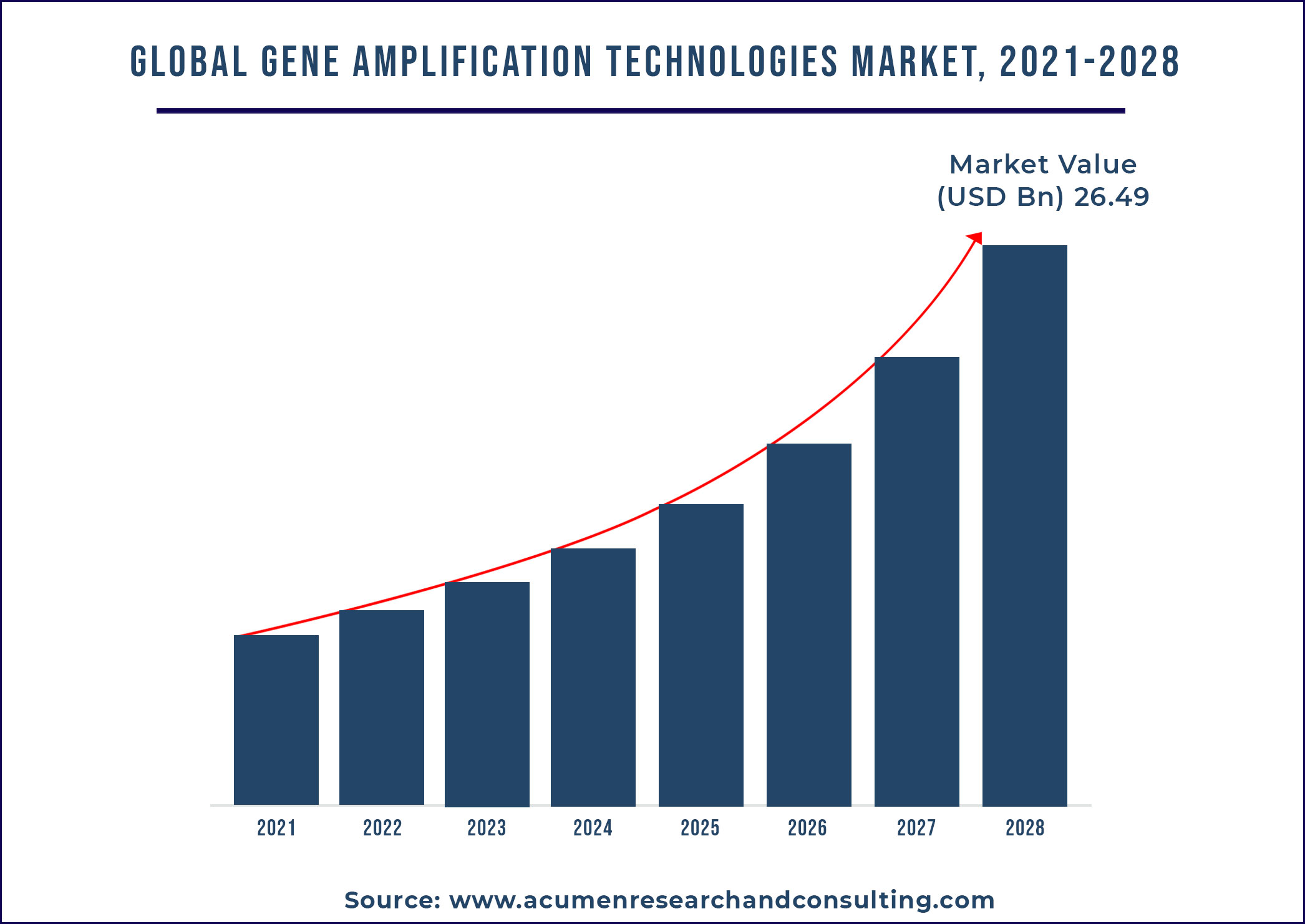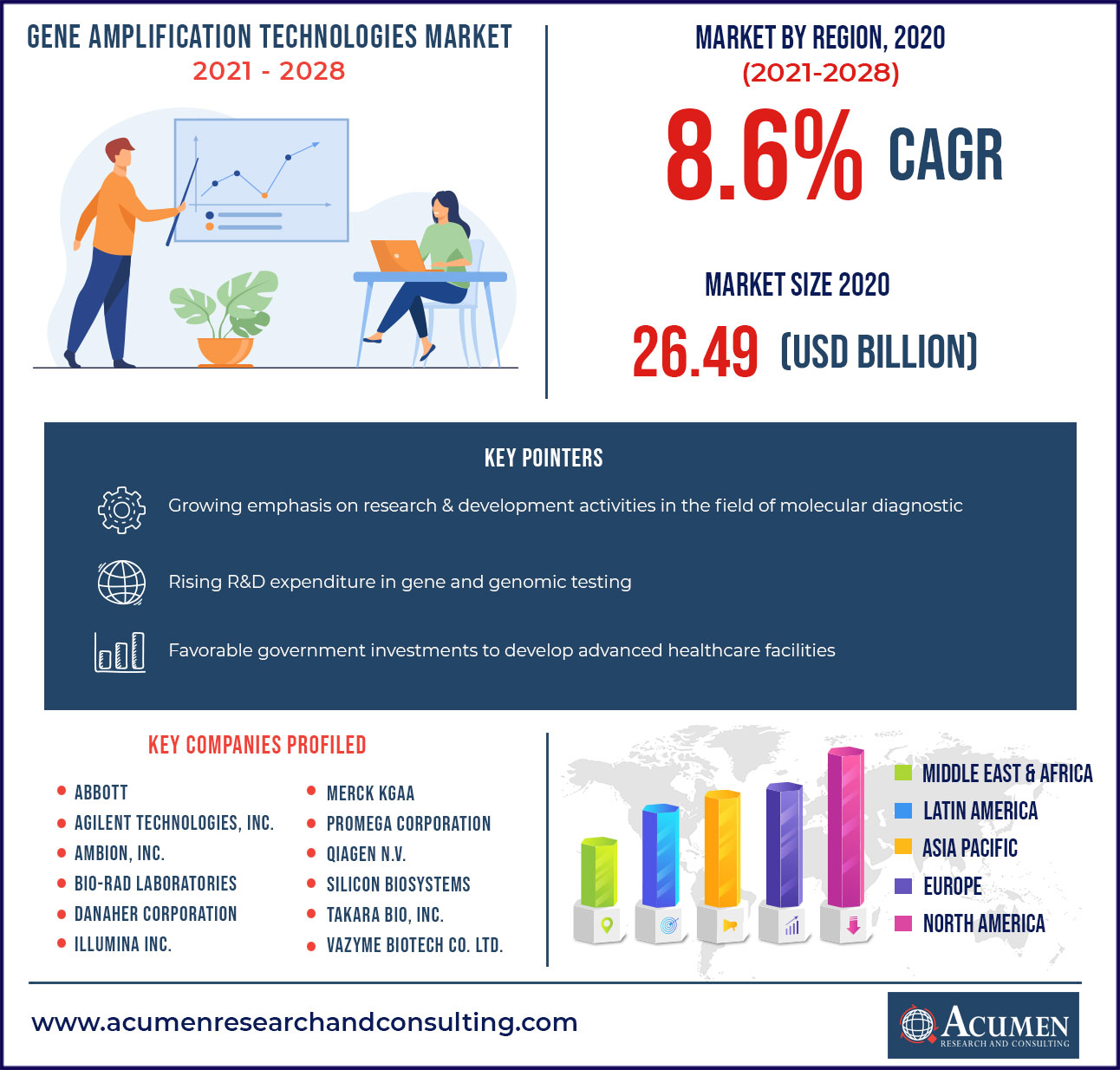September 2022
Gene Amplification Technologies Market Accounted For US$ 26.35 Bn In 2020 And To Surpass US$ 50.64 Billion By 2028 With A Considerable CAGR Of 8.6% During The Forecast Period Of 2021 To 2028.
The global gene amplification technologies market accounted for US$ 26.49 Bn in 2020 with a considerable CAGR of 8.6% during the forecast period of 2021 to 2028.

According to the National Human Genome Research Institute, gene amplification is an increase in the number of copies of gene sequence without a proportional increase in other genes. This results from a duplication of a region of DNA that contains a gene through errors in DNA replication and repair machinery. Gene amplification can also be referred to as the polymerase chain reaction (PCR); a laboratory technique used to amplify gene sequences in a test tube, which is in tremendous demand owing to the COVID-19 pandemic. Gene amplification technology plays a crucial role during development when it is responsible for the programmed increase of gene expression.
Report coverage
| Market | Gene Amplification Technologies Market |
| Analysis Period | 2017 - 2028 |
| Base Year | 2020 |
| Forecast Data | 2021 - 2028 |
| Segments Covered | By Technology, By Application, By Sample Type, By Product, By End-Use, and By Geography |
| Regional Scope | North America, Europe, Asia Pacific, Latin America, and Middle East & Africa |
| Key Companies Profiled |
Abbott Laboratories, Agilent Technologies, Inc., Ambion, Inc., Bio-Rad Laboratories, Danaher Corporation, Illumina Inc., Merck KGaA, Promega Corporation, QIAGEN N.V., Silicon Biosystems, Takara Bio, Inc., Vazyme Biotech Co. Ltd., and others. |
| Report Coverage |
Market Trends, Drivers, Restraints, Competitive Analysis, Player Profiling, Regulation Analysis |
| Customization Scope |
10 hrs of free customization and expert consultation |
Market Dynamics
The global gene amplification technologies market is primarily driven by the Human Genome Project (HGP). The Human Genome Project was a worldwide scientific research project to determine the base pairs that compose human DNA. It was the world’s largest collaborative biological project that started in 1990 and was declared completed in April 2003. However, Level "complete genome" was attained in May 2021.
In addition, growing emphasis on research & development activities in the field of molecular diagnostic, genetic & genomic testing, drug discovery, and environmental monitoring among others are also boosting the global gene amplification technologies market share. For instance, genomic testing is commonly used in cancer treatment to determine the behavior of the tumor. It further helps healthcare professionals to predict how progressive cancer will be and whether it is likely to spread to other body parts. According to the reports, Global Cancer Observatory (GLOBOCAN) and International Agency for Research on Cancer states that an estimated 19.3 million new cancer cases were diagnosed in 2020. Also, cancer is the leading cause of death the world. According to estimates from the World Health Organization (WHO) in 2019, cancer is the first or second cause of death before 70 years in most of the countries in the world.
However, the high costs of these technologies and limited awareness in emerging economies are the factors that might restraint the market from growing. Moreover, technological advancement in the field of advanced DNA multiplication technologies will contribute to profitable opportunities for the market in the coming years.
Increasing research & development activities in the field of molecular diagnostics fuels the gene amplification technologies market growth
The molecular diagnostics industry has been playing a vital role in the screening, detection, and monitoring of numerous life-threatening diseases. This industry is quickly evolving and has established itself as a significant part of the healthcare industry. Clinicians have benefited from molecular diagnostic tools such as polymerase chain reaction (PCR), sequencing, and hybridization, as well as microarray, by providing rapid and sensitive approaches for the screening, detection, and monitoring of a wide range of genetic disorders, cancers, infectious, and chronic diseases
Impact of the Covid-19 Pandemic on Gene Amplification Technology Industry
The pandemic has increased the pressure on the sector to handle the issues it faces. The COVID-19 pandemic has tested the healthcare ecosystem of even the most developed economies. With the addition of the quick antigen detection test to the molecular tests, which remain the basis of diagnosis, the testing rate has increased dramatically in recent months. The government's increased focus on testing has expedited the need, demand, and responsibility of the world's diagnostic business, particularly the molecular diagnostic sector, which has proven to be the backbone, supporting containment efforts to minimize the outbreak.
Market Segmentation
The global gene amplification technologies market is segmented based on technology, product, sample type, application, end-use, and region. Based on the technology segment, the market classifies as PCR-based amplification, multiple displacement amplification, nucleic acid sequence-based amplification, loop-mediated isothermal amplification, strand displacement amplification, rolling circle amplification, ramification amplification, and others.

Based on product, the segmentation bifurcates into instruments, kits & reagents, and services. The sample type segment is further categorized into a single cell, FFPE, and others. The application segment is further sub-segmented into whole genome amplification, exome sequencing, SNP genotyping arrays, array CGH, hybridization, and other applications. Furthermore, pharmaceutical & biotechnology companies, academic & research institutes, and others.
Regional Overview
North America region is expected to lead global gene amplification technologies market during the projected period of 2021 to 2028
Among all the regions, North America generated the highest revenues in 2020, accounting for a significant market share in the global market. This is attributed to the presence of several advanced healthcare facilities, tremendous growth in genetic testing, and ongoing research programs in the region. For instance, in Sept 2021 - GeneDx, Inc. a US-based genomic analysis leader announced the completion of clinical genetic exome sequencing for more than 300000 patients, making the company’s dataset the largest of its kind in the world. Besides, growing funding by numerous government organizations in medical research and its infrastructure is also likely to boost the North American gene amplification technologies market growth.
Europe has also exhibited significant growth in the global market, owing to the growing focus on innovations through R&D, and the presence of advanced healthcare facilities in countries such as Germany, the UK, and others. Meanwhile, the Asia-Pacific region is likely to register the fastest CAGR throughout the forecast period on account of the increasing prevalence of various diseases that lets the growing need in genomic research. Moreover, favorable government initiatives to develop advanced healthcare facilities in countries such as China and India are also expected to propel the demand for the APAC gene amplification technologies market.
Competitive Landscape
This section of the report pinpoints various key vendors of the market. Some of the key players offered in the report include Abbott Laboratories, Agilent Technologies, Inc., Ambion, Inc., Bio-Rad Laboratories, Danaher Corporation, Illumina Inc., Merck KGaA, Promega Corporation, QIAGEN N.V., Silicon Biosystems, Takara Bio, Inc., Vazyme Biotech Co. Ltd., and others.
Market Segmentation
Market By Technology
Market By Application
Market By Sample Type
Market By Product
Market By End-Use
Market By Geography
Looking for discounts, bulk pricing, or custom solutions? Contact us today at sales@acumenresearchandconsulting.com
September 2022
May 2023
July 2020
February 2021